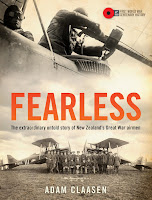When you think of WWI, the first thought are the troops on the ground, and our miners aka tunnellers - but we often forget those brave men who first fought in the sky.
Thames has the honour of having had four men who were pilots in World War One. A new book from Massey University Press called Fearless by Adam Claasen has information on our men.
1. While remembered by many for his efforts in World War Two, Sir Keith Park, then just Pilot Keith Park went on to be highly distinguished and received several awards.
Park was born and initially schooled in Thames. Initially during WWI, Park was an instructor, which led him to having had many more flying hours than most pilots flying in 1917.
The book Fearless covers Park's experiences in the war and how he rose from pilot to commander. "Keith Park's sterling work in 1917, when he and observers between them accumulated 16 victories in the Bristol fighter, saw him promoted to Major Park, commanding 48 Squadron in 1948." Claasen page 296.
 |
| Major K.R. Park, O.C. 48th Sqdn. R.A.F. -/6/1918 with his 275 Rolls Engine in Bristol Scout (120mph). Source: AWM Cenotaph contributor. |
 |
| Flight Sub-Lieutenant Euan Dickson RN |
"Sub-lieutenant E. Dickson, who made many friends while he was at Thames a few years ago, is now doing good work in the Royal Flying Corps in France. Lieut. Dickson participate in a recent air raid when 15 German machines were destroyed." Thames Star, 12 December 1917. Dickson went on to be awarded the Distinguished Flying Cross.
"Dickson undertook more bombing sorties than any other airman in the Great War, and went on to become one of the two most successful bomber pilots in aerial combat." Claasen page 331.
 |
| Albert Gordon. |
His love of flying led him to train at Kohimarama and he became a member of the Royal Flying Corps. The rest is sadly history, and Thamesite Albert Gordon became the "first New Zealand trained pilot to be killed in action in World War I." (Roger Strong, NZ Memories Issue 130)
Gordon was wounded while flying in a battle that took him completely by surprise during what should have been a routine flight. "Within hours the newcomer would be in hospital with two broken legs, thanks to a nasty crash landing." Claasen page 281. He was transferred to England but died of wounds received in action.
 |
| Thames Star 12 August 1918. |
"Paul and his observer William Weir were jointly awarded the Distinguished Flying Cross on 8 February 1919. Paul never knew of the honor; while on the voyage home to New Zealand, he drowned on 22 January 1919." Wikipedia.
Further Reading:
Air Vice Marshall Sir Keith Park, by Kae Lewis, The Treasury Journal - Our People.
Carrick Stewart Paul at AWM cenotaph entry.
Euan Dickson, D.F.C. by Roger Strong in Treasury Journal Volume 9 2016.
Fearless by Adam Claasen, Massey University Press.
Thamesite Albert Gordon, by Althea Barker - blog entry.
